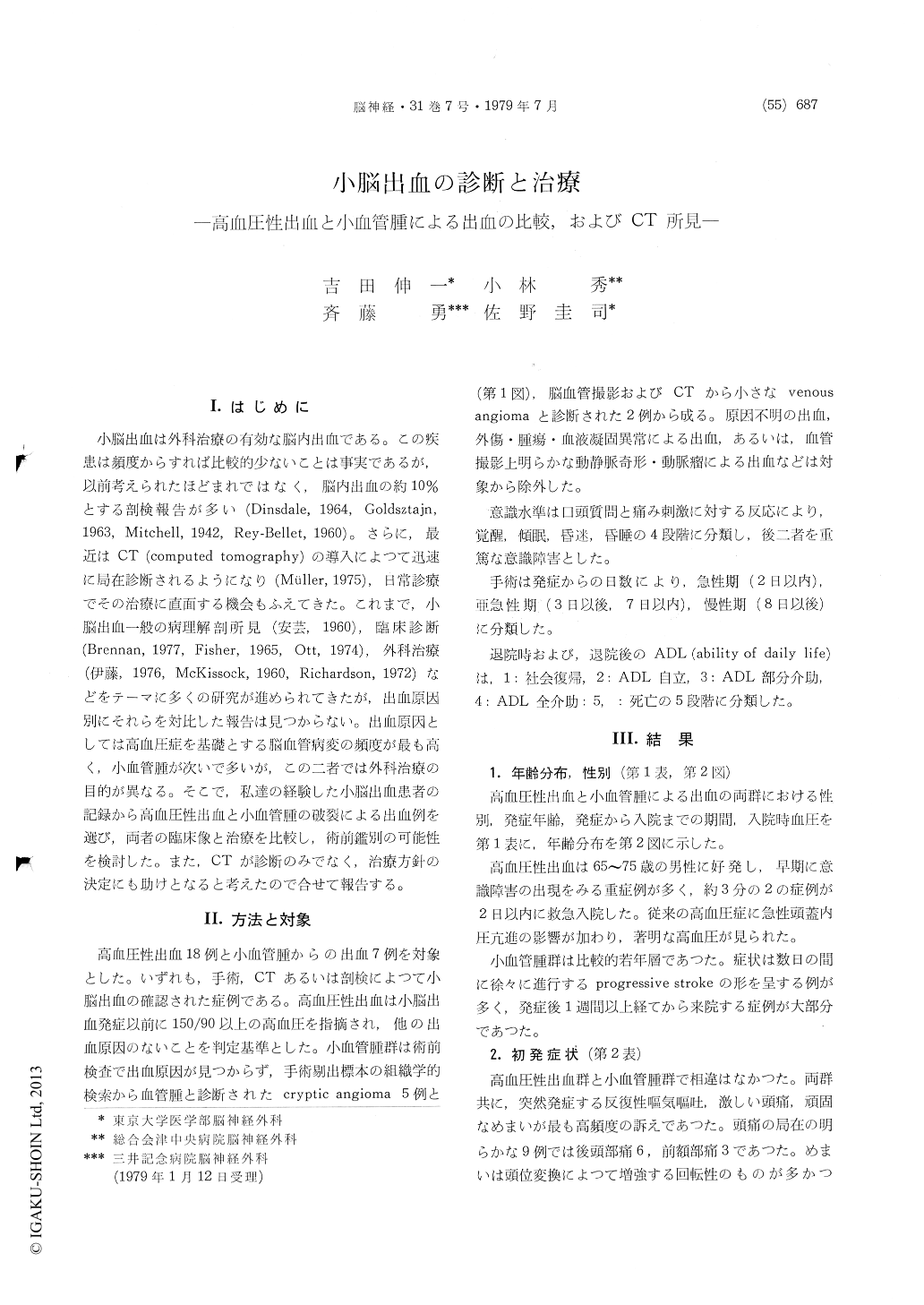Japanese
English
- 有料閲覧
- Abstract 文献概要
- 1ページ目 Look Inside
I.はじめに
小脳出血は外科治療の有効な脳内出血である。この疾患は頻度からすれば比較的少ないことは事実であるが,以前考えられたほどまれではなく,脳内出血の約10%とする剖検報告が多い(Dinsdale,1964,Goldsztajn,1963,Mitchell,1942,Rey-Bellet,1960)。さらに,最近はCT (computed tomography)の導入によつて迅速に局在診断されるようになり(Muller,1975),日常診療でその治療に直面する機会もふえてきた。これまで,小脳出血一般の病理解剖所見(安芸,1960),臨床診断(Brennan,1977,Fisher,1965,Ott,1974),外科治療(伊藤,1976,McKissock,1960,Richardson,1972)などをテーマに多くの研究が進められてきたが,出血原因別にそれらを対比した報告は見つからない。出血原因としては高血圧症を基礎とする脳血管病変の頻度が最も高く,小血管腫が次いで多いが,この二者では外科治療の目的が異なる。そこで,私達の経験した小脳出血患者の記録から高血圧性出血と小血管腫の破裂による出血例を選び,両者の臨床像と治療を比較し,術前鑑別の可能性を検討した。また,CTが診断のみでなく,治療方針の決定にも助けとなると考えたので合せて報告する。
In spontaneous cerebellar hemorrhage emergency surgical intervention is often life-saving. Clinical features and the operative results of hypertensive cerebellar hemorrhage (18 cases) were compared with those of hemorrhage caused by small angiomas (7 cases). Hypertensive hemorrhage occured most frequently in the seventh decades. Two thirds of the patients developed brainstem compression syndrome within a week from onset. One third remained awake or drowsy throughout their clinicalcourse. Surgical removal of a hematoma was carried out in 13 patients with four deaths. Of note, two comatose patients regained consciousness after surgery, and were discharged with residual ataxia. Rupture of a small angioma occurred in younger patients. Their clinical course was sub-acute or chronic associated with focal cerebellar dysfunction. All seven surgically treated patients subsequently regained independent function.
CT findings have been found helpful not only for diagnosis but also in defining appropriate therapy. Hematomas larger than 3 cm in diameter produced signs of rapidly progressing compression of the brainstem. Thereby, regardless of the cause of bleeding, emergency removal of a clot is indicated even in awake patients. Hematomas of 2 to 3 cm produced brainstem compression or prolonged cerebellar dysfunction, and occasionally require surgical decompression. Hematomas smaller than 2 cm can be managed conservatively, since they were absorbed spontaneously in three weeks without residual functional disturbances. However, in case of a young patient exploration should be performed for a probable "cryptic" angioma.

Copyright © 1979, Igaku-Shoin Ltd. All rights reserved.


